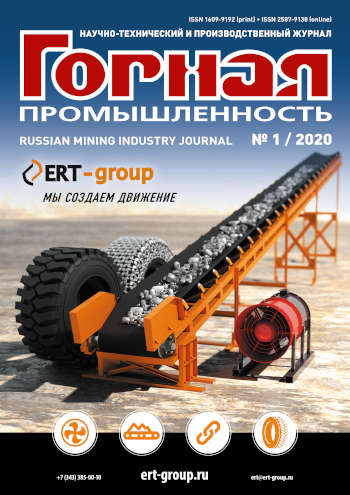№ 1 / 2020

Dear readers!
Starting with the first issue of the Mining Industry Journal in 2020 we launch a series of publications on the development of natural resources in the Russian Arctic, understanding these resources primarily as mineral and raw materials.
Commercial development of mineral resources of the Arctic region began in the 1930-s and the 1940-s: coal excavation was started in the cities of Vorkuta and Inta, fertilizers were produced in Apatity, polymetallic ores were mined in Norilsk while gold and silver were supplied from Magadan. We all know the cost of this development - the infamous Gulag methods are no longer a secret. At the same time, this expansion into the Arctic region was made using domestically produced machinery and equipment, while science, technology and practical experience helped to overcome various challenges concerned with large-scale construction of such large cities as Norilsk, Vorkuta, Inta, Apatity, and many others. Over a million people lived beyond the Polar Circle.
Apart from Russia, mineral resources within the Polar Circle were mined by Sweden, Finland, the USA and Canada. The nature generously endowed the Arctic with such commodities as gold, diamonds, polymetals, oil, gas and coal. The reserves of rare-earth elements are of particular importance for the emerging digital and low-carbon economy. The supposedly coming global warming is opening up a totally new level of possibilities and opportunities for the extraction of natural resources and their delivery to the consumers. This is already a part in the picture of growing economic and military activities in this region, both from the Arctic countries and from the new players, most notably China. The military and political dimension - as the immediate future trends show - has an important role to play in the future development of the Arctic.
In this context, the Russian government and big business are active in starting to explore the Arctic territories through top-scale investment projects. Among other projects, Gazprom has started the development of the Prirazlomnoye Oil Field, the Yamal LNG project was launched by NOVATEK in August 2018, the coal business intends to develop the coal deposits of the Taimyr, Norilsk Nickel is investing in expansion of their mines and has already starting mining operations at a depth of 2 km - for the first time in Eurasia.
In this connection, as President of the Academy of Mining Sciences, I wish to stress that many of the natural factors in these areas have been poorly studied or are completely unknown. In many ways, the Arctic Region remains a Terra Incognita both theoretically and in practice. The obscurity is further amplified by the poorly studied consequences of possible global warming.
 Given the importance of the Arctic mineral wealth for the mining as well as the oil and gas sectors, the Mining Industry Journal starts publishing important articles within the "Arctic Series" already in this first issue. Thus, the paper by V.I. Bogoyavlenskiy, Corresponding Member of the Russian Academy of Sciences, entitled "Natural and Man-Made Threats in Development of Fossil Fuel Deposits in the Earth Cryolithosphere” and certainly “Mineral Resources and Future of Arctic” by Professor V.B. Kondratiev, Doctor of Economics, Head of the Center for Industrial and Investment Studies at the Primakov Institute of World Economy and International Relations, intoduce the readers to the current state and prospects of mining industry development in the Arctic, including the challenges in infrastructure development and environmental protection.
Given the importance of the Arctic mineral wealth for the mining as well as the oil and gas sectors, the Mining Industry Journal starts publishing important articles within the "Arctic Series" already in this first issue. Thus, the paper by V.I. Bogoyavlenskiy, Corresponding Member of the Russian Academy of Sciences, entitled "Natural and Man-Made Threats in Development of Fossil Fuel Deposits in the Earth Cryolithosphere” and certainly “Mineral Resources and Future of Arctic” by Professor V.B. Kondratiev, Doctor of Economics, Head of the Center for Industrial and Investment Studies at the Primakov Institute of World Economy and International Relations, intoduce the readers to the current state and prospects of mining industry development in the Arctic, including the challenges in infrastructure development and environmental protection.
The Editorial Board is looking forward to fruitful cooperation with scientists and experts, representatives of the business community and our readers in general in covering Russia's achievements in developing its Arctic wealth.
- Yu.N. Malyshev,
Editor-in-Chief of the Russian Mining Industry,
President of the Academy of Mining Sciences, Academician of the Russian Academy of Sciences,
President of Vernadsky State Geological Museum of the Russian Academy of Sciences.
Original Paper
Mineral resources and future of the Arctic
Natural and technogenic threats in fossil fuels production in the Earth cryolithosphere
Implementation monitoring of safety at the construction area of a steep-inclined conveyer complex at the south open pit of Mikhailovsky GOK
![]() R.I. Ismagilov1 , A.V. Kozub2, B.P. Badtiev1, A.A. Pavlovich3
R.I. Ismagilov1 , A.V. Kozub2, B.P. Badtiev1, A.A. Pavlovich3
1 Management Company Metalloinvest, LLC, Moscow, Russian Federation
2 Mikhailovsky Mining and Processing Plant JSC, Zheleznogorsk, Russian Federation
3 Saint-Petersburg Mining University, St Petersburg, Russian Federation
Russian Mining Industry №1 / 2020 p. 120-126
Vehicle Positioning and Monitoring in Underground Mines
Features and prospects of the implementation of the draft federal norms and rules in the field of industrial safety «Rules for ensuring the stability of sides and ledges of quarries, open pits and dumps»
![]() M.V. Rylnikova1, A.I. Perepelitsyn2, O.V. Zoteev3, I.L. Nikiforova1
M.V. Rylnikova1, A.I. Perepelitsyn2, O.V. Zoteev3, I.L. Nikiforova1
1 Science Institute of Comprehensive Exploitation of Mineral Resources Russian Academy of Sciences, Moscow, Russian Federation
2 Federal Service for Environmental, Technological and Nuclear Supervision (Rostekhnadzor), Moscow, Russian Federation
3 Science Institute of Mining Ural Branch of the Russian Academy of Sciences, Yekaterinburg, Russian Federation
Russian Mining Industry №1 / 2020 p.132-139
Mineral Potential of Subsea Deposits in Vietnamese Part of South China Sea
Radar Interferometry as Supplement to Classical Methods to Observe Earth's Surface Displacement
Hygienic Assessment of Noise and Vibration Affecting Workers at Mining Operations
Calculation of Productivity and Justification of Cassette-Type Sweeper Parameters for Ferro-Manganese Nodule Mining
![]() A.S. Kashirskiy1, M.G. Rakhutin2, Yu.V. Kirichenko2, E.A. Kuzin3, G.S. Ivashchenko2
A.S. Kashirskiy1, M.G. Rakhutin2, Yu.V. Kirichenko2, E.A. Kuzin3, G.S. Ivashchenko2
1 RF Ministry of Industry and Trade, Moscow, Russian Federation
2 Mining Institute of National University of Science and Technology MISIS, Moscow, Russian Federation
3 Committee for State Construction Supervision of the City of Moscow, Moscow, Russian Federation
Russian Mining Industry №1 / 2020 p.155-159





